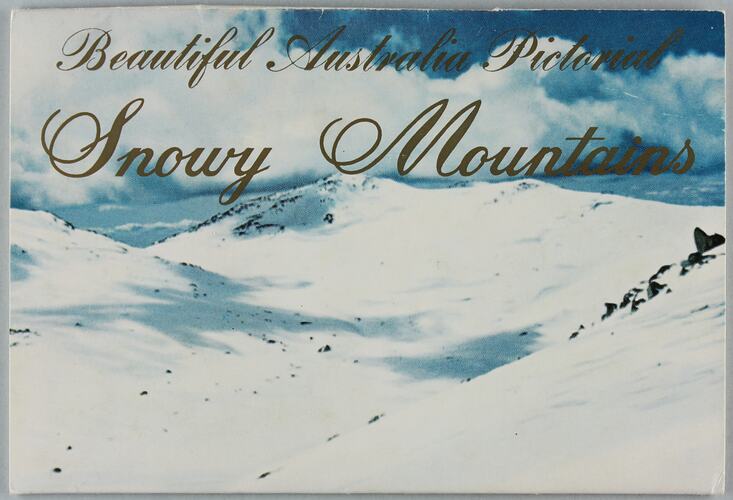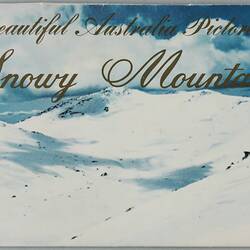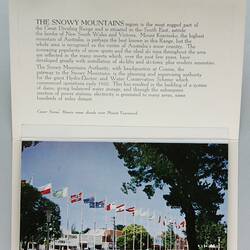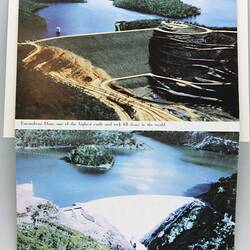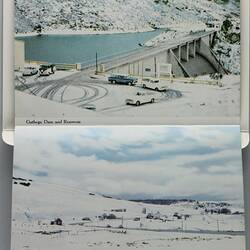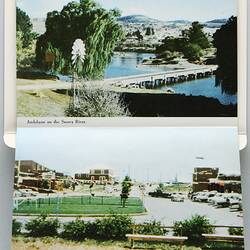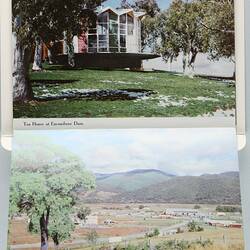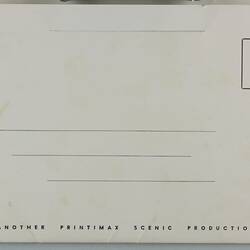Summary
Fold-out full colour postcard set, probably amongst a group of brochures promoting New South Wales received by Dorothea Huber [nee Freitag and later Dunzinger] prior to her her migrant voyage from Austria to Melbourne in 1959. The postcards feature various colour images of the Snowy Mountain area including Cooma, Cabramurra and Adaminaby townships, Jindabyne, Eucumbene, Guthega and Tumut Pond dams, and Thredbo, Kiandra and Mt Kosciusko ski resorts.
Born in 1929 near Graz, Austria, Dorothea was a proficient recreational skier and part of a volunteer rescue team in Switzerland. She lived and worked primarily as a mill weaver and seamstress in England, Switzerland and Austria before migrating to Australia from Austria on 30 November 1959, arriving on the Cogedar Line ship 'Flaminia' on 31 December. She settled in Melbourne and married fellow Austrian Johann Dunzinger whom she met at Broadmeadows migrant hostel. They had a daughter Caroline and lived in various Melbourne suburbs boarding and renting before building a home in Kalorama. The couple divorced in1978. Dorothea worked hard all her life, owning a boutique clothing shop in Camberwell at one stage but primarily as a textile outworker and factory worker trying to make ends meet. She died in 2001.
Physical Description
Full colour set of fold-out postcards. Gloss envelope cover with title and image of snow-covered mountain slopes on front and plain reverse side with space for postal details and stamp. Six two-sides colour postcards fold out featuring different scenes around the Snowy Mountain area.
Significance
The Dunzinger Austrian Migrant Collection has evolved to become a rich group of objects which tell a particular story of an Austrian woman's post-war migration experiences, as well as broader contextual narratives relating to the variety of selection and management processes in place in Europe after World War II. These include references to Australian-specific organisations involved in migration management such as the Australian Migration Mission. Items explore the enthusiastic promotional activities of the Australian Government to encourage migration from the UK and Europe in order to populate Australia and build a workforce. Artefacts also relate to a significant Italian migrant ship of the period, the Cogedar Line 'Flotto Lauro'.
There is a also symbolic poignancy about the skis and the small sewing machine Dorothea Dunzinger brought with her from Austria: the skis representing precious mementoes from home and hopes and expectations for the leisure activity they might bring in Australia; the sewing machine a pragmatic object which came to dominate Dorothea's actual settled life of hard work both in the home and as an outworker with no leisure time at all.
More Information
-
Collecting Areas
-
Acquisition Information
Donation from Ms Caroline Dunzinger, 07 Nov 2012
-
Past Owner & User
-
Place & Date Depicted
Australia: Snowy Mountains Authority, New South Wales, Australia, circa 1950s
-
Inscriptions
Front cover title: 'Beautiful Australian Pictorial/ Snowy Mountains'. Inside front cover: 'THE SNOWY MOUNTAINS' followed by extensive text.
-
Classification
-
Category
-
Discipline
-
Type of item
-
Overall Dimensions - Closed
155 mm (Width), 105 mm (Height)
-
Keywords
Austrian Immigration, Post War Migration, Skiing, Holiday Resorts, Holidaying, Holidays, Tourism
